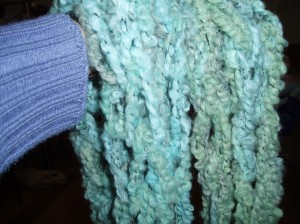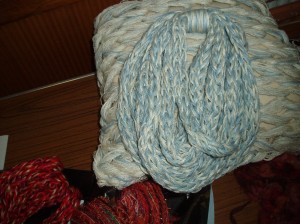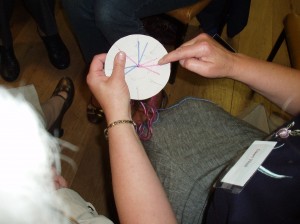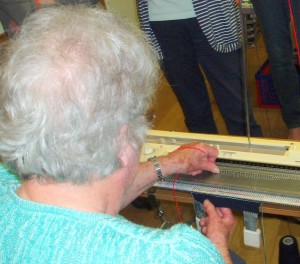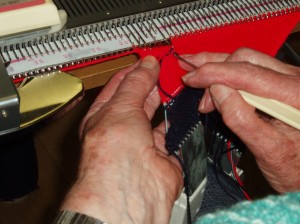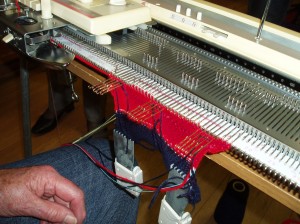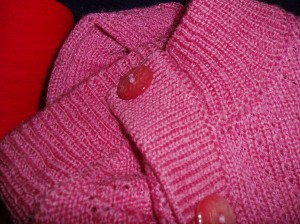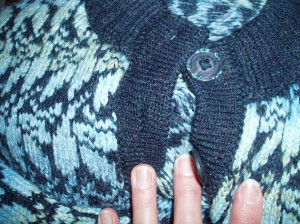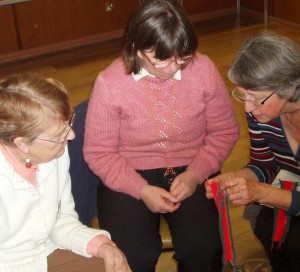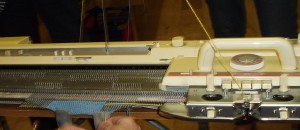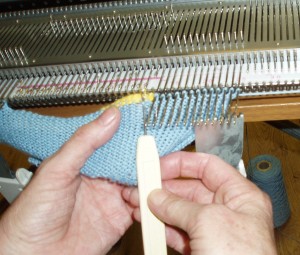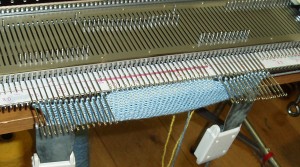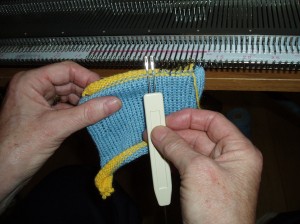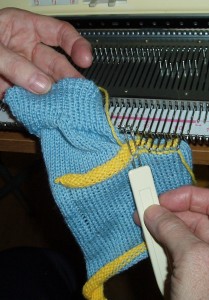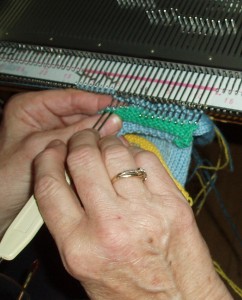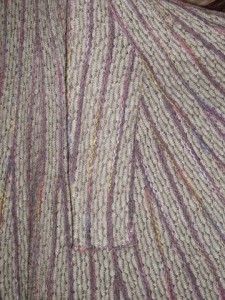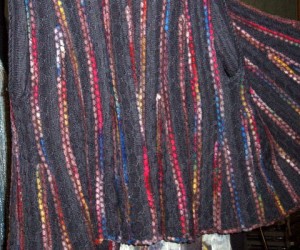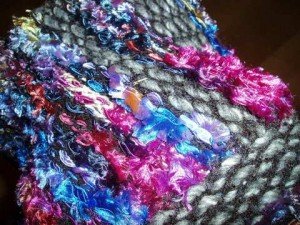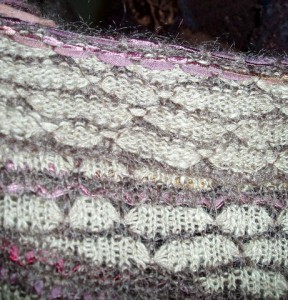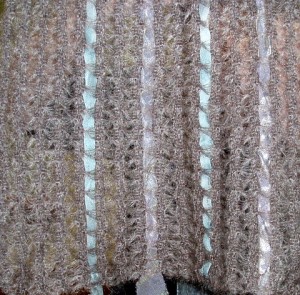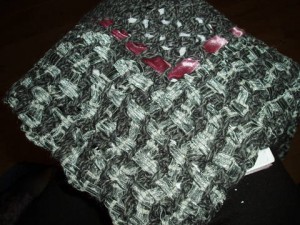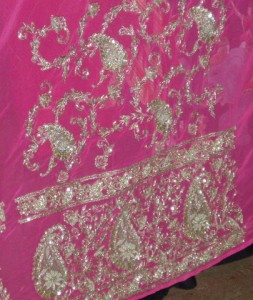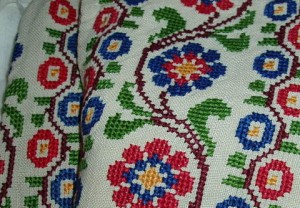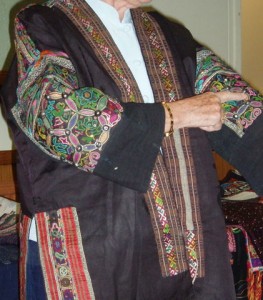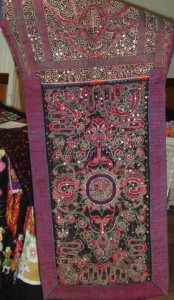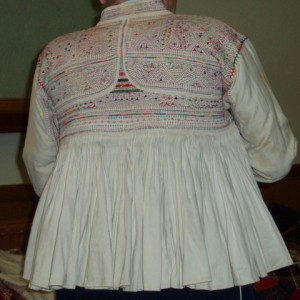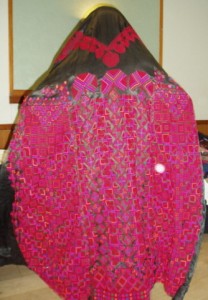On Saturday 9 November, 10am to 4pm
The Iris Bishop Workshop will be held in our old hall in Effingham, the Catholic Church hall,
for those of you who are not familiar with the hall, it on Lower Road which runns through Bookham Village and is nearly at the end, just past the British Legion and on the opposite side from the Howard of Effingham School (but further along).
The entrance to the drive up to the Catholic Church is next to the exit from the hall car park but the hall is behind a large hedge and the entrance is at the far end of the hedge (if you are coming from Bookham). It is easy to miss but at the end of the road you can go right round the mini roundabout and try again.
Author: Lyn Leventhall
July 2013 Meeting
We welcomed Jo Thompson from Morley College today. She gave a lovely talk about how she got into machine knitting and her progress from student through until today via making garments and swatches for a living and supplying a knitwear boutiques in the USA and elsewhere with beautiful hand crafted garments of her own design.
We were fascinated by the variety and originality of swatches she had brought along and the examples from the student’s work she had collected together from the class she now teaches in experimental machine knitting.
Here are a selection of items from the huge pile of exciting items she brought to show us.
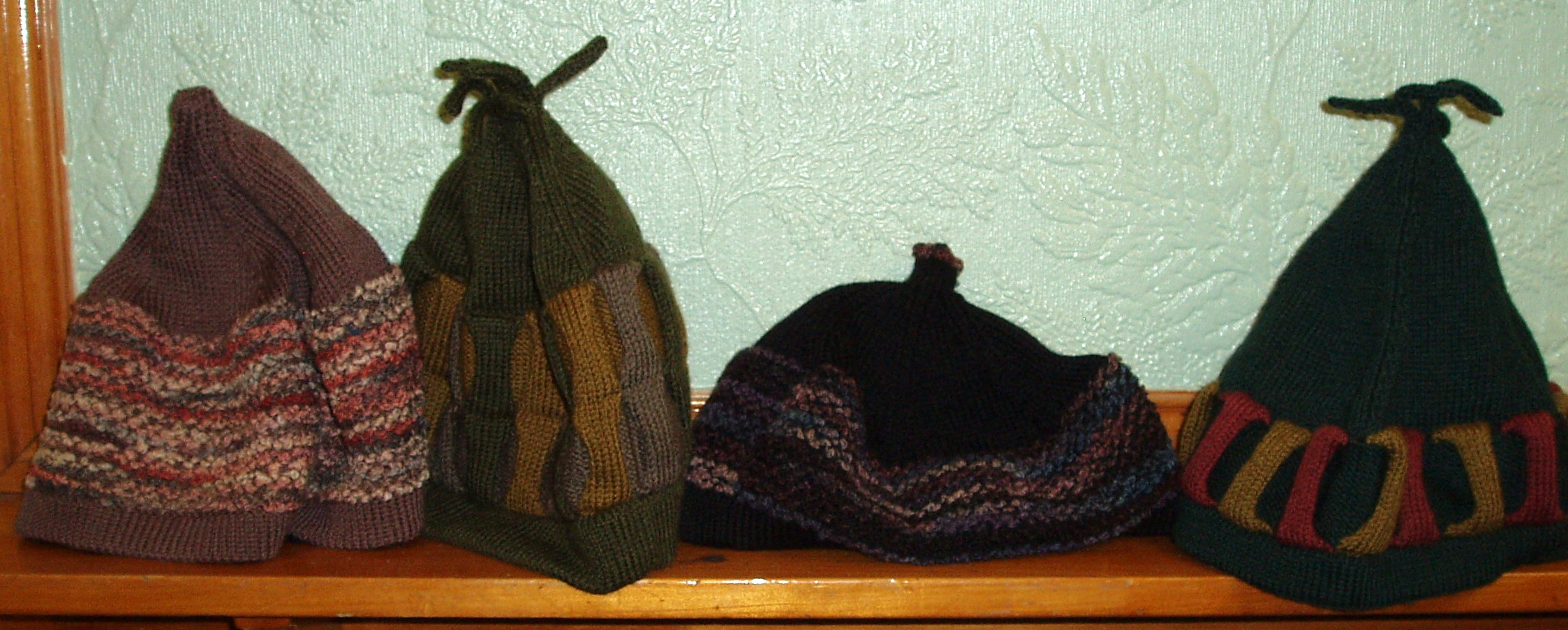
There are a variety of hats here with different styles of decoration.
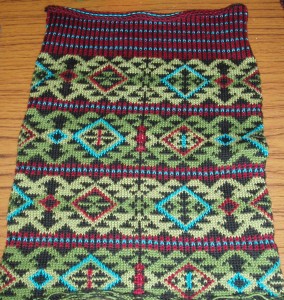
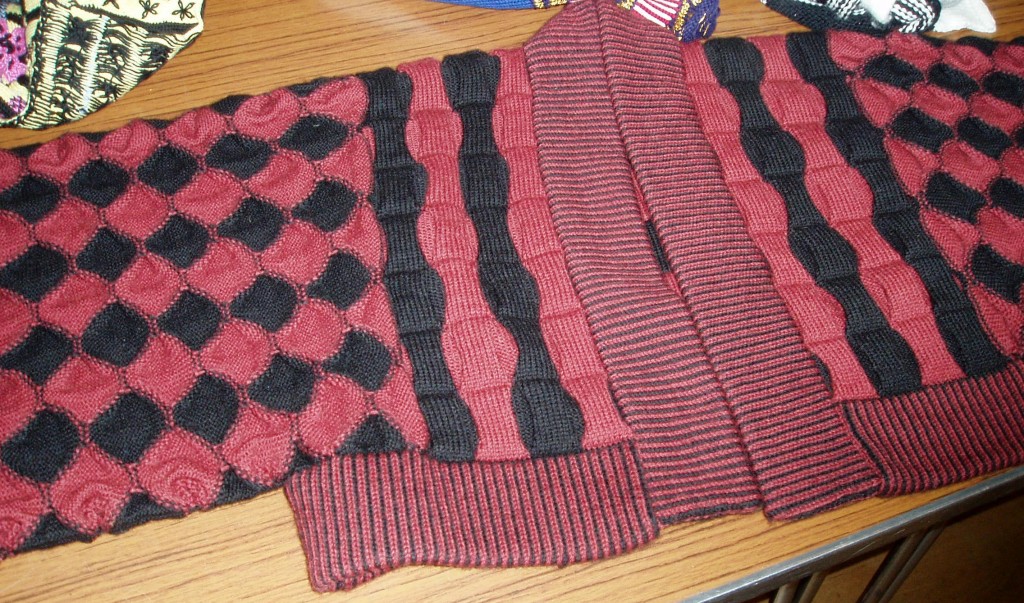
June 2013 Meeting
Due to a cancellation by the planned speaker this month several members got together to demonstrate some crafts they were having fun with.
- Margaret showed us Arm knitting
- Gillian had been trying finger knitting
- Dawn demonstrated Japanese Braid making
After a demonstration of each craft we split up into groups and all enjoyed trying one or more of these out with varying success.
Margaret made some cowls with the large knitted cords that she had tried, she used several ends of yarn to create a thick enough yarn to give a good effect, this is useful for using up all those odds and ends you have in your stash.
| The braid is made on a circular card with slits round the edge, then the threads are moved around and crossed to create different patterns. In Japan, this is an art form called Kumihimo and wonderful colourful braids are made with silk and metallic threads. To learn more, look at one of a number of demonstrations on YouTube. | |
Show and Tell
Several members brought in garments they had made recently to the show and tell at the end of the evening, 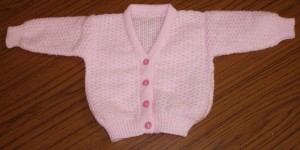
- Baby Cardigan in pink
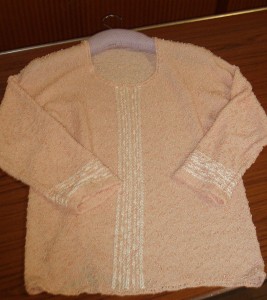
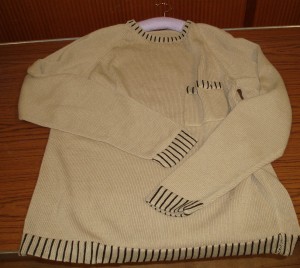
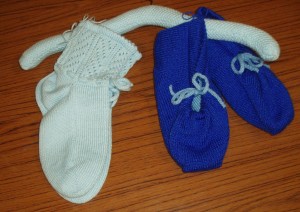
May 2013 Meeting
This was a club night where members of the club gave a demonstration.
Our Chairman Kathy welcomed Sue Potter, the new Surrey regional officer from the Guild of Machine Knitters, who was visiting us for the first time.
We also extended a welcome to two more guests who are interested in machine knitting.
The first demonstration was by Brenda who showed us how she does button/button hole bands on a cardigan.
he gave us a rule of thumb for the band length – as a starting point then described various types of button bands – edges picot, plain, tucked to give a scalloped effect, single or double (better).
The tensions relate to the garment tension – in general the button band should be T-1 and the fold row T+2.
The final row after picking up the garment edge on machine should be the same tension as the garment.
Choose the number of rows to be even so buttonhole is central (excluding the turning row) 8 or 16 for example as this ensures top button in particular is central as it would show up more.
A quick tip: you can put button small holes on the join between the band and the garment, done when picked up so no separate button hole required – easy to do but garment needs to be V neck or top button will be offset to one side! It is suitable for narrow bands only.
In general, the button band should run up and over the neckband for more slimming look.
Older styles of garment were the opposite, finishing below neckband.
Generally bands are stocking stitch even if other bands on the garment are ribbed, a ribbed band it can cause a problem with tension matching.
Frances then showed us how to put a pocket in a cardigan or jumper. This method needs no sewing up apart from catching in the pocket top after the rest is completed. It makes a neat and flat pocket with your own choice of trims at the top.
Full Instructions will be available later.
Last but not least, the show and tell
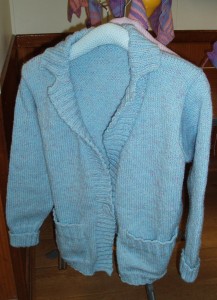
Gill, one of our newest members brought in a cardigan she had made on her recently acquired Zippy 90, a plastic bed chunky with only 90 needles.
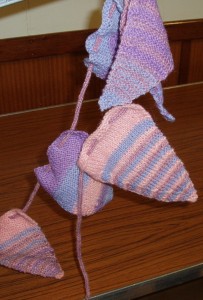
Gillian had made some bunting and brought that along for us to see.
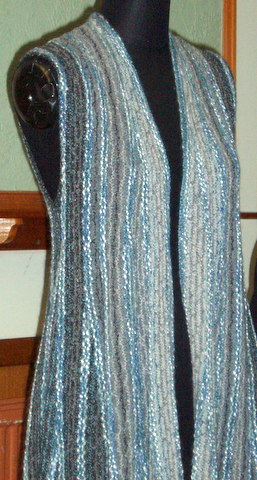
April 2013 Meeting and AGM
After the formal business of the AGM, we were delighted to welcome Iris Bishop who is a favourite speaker at our club. Her talk was very entertaining and the garments and samples she brought along were a real feast for the eyes. As usual her emphasis was on creating lovely fabric using her trusty machine. Many of the items had woven elements and her combinations of colours and yarn made some really fabulous innovative fabrics. The yarns used varied from the industrial fine yarn to really chunky yarn and all, amazingly, worked on a standard gauge machine.
She showed us various garments and samples as well as giving detailed descriptions of how these were created.
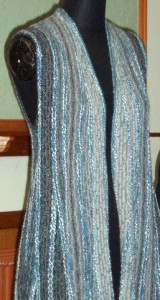
We all enjoyed such an inspirational speaker whose no nonsense approach to knitting gave us all hope that we can achieve some of those lovely fabrics by following her patterns.
Close up of some of the fabrics
March 2013 Meeting
After some notices, Kathy, our chairman, welcomed our speaker Jennifer Hughes from Surrey Weavers talking on embroidered textiles of from around the world and especially from South East Asia.
She had brought a dazzling array of garments and sample from her extensive collection. She explained that many patterns of garments had ancient folklore associated with them, especially embroidery around the edges of garments, it was thought that evil spirits could be warded off by red patterns around the cuffs, necklines and at the bottom hems. In addition, many women’s garments had embroidery covering their reproductive areas as can be seen on items with embroidery across the bust and over the stomach and sometimes at the back. Aprons for example had originally been garments not to keep your clothes clean but as a protection against evil spirits.
Much of the work was very fine indeed, minute stitches covering both garments and linen and table cloths. Sometimes done by mothers and grandmothers for a girl’s trousseau. They were a display of wealth and status. Some garments embroidered with gold coloured thread had patterns representing jewellery such as necklaces and even earrings sewn on and this might have been done for a girl whose parents could not afford real gold jewellery for her wedding.
Many of these ancient craft skills were dying out in parts of the world when girls attended school rather than learning these at home. The respect for the needlecraft skills was lost once their societies moved into a more modern world were machines replaced hand sewn embroidery.
There were also a range of items to buy.
Margaret thanked everyone who had contributed baby jumpers and hats for the “Fish and Chip” babies in Malawi. So far we have over 25 jumpers to send off to the collection point in Scotland. She encouraged us to keep going. Any baby jumper pattern will be acceptable just so long as they are darker colours.
Finally there was a show and tell session in which several people showed us what they have been making.
Brenda brought this jumper, made for members of a bridge club.

Members were reminded that the AGM will be held next month and Iris Bishop will be our speaker. It is starting at 7:30 for the club business before the meeting.
Craft Show, Sandown Park.
Sandown Park Exhibition Centre, Esher, Surrey
5 – 7 September 2013
AGM followed by Speaker: April Hardman
April 9 AGM + April Hardman
Club evening + raffle
March 12 club evening +raffle
Club competition followed by a wine & cheese social.
Feb 12 competition, wine & cheese,

